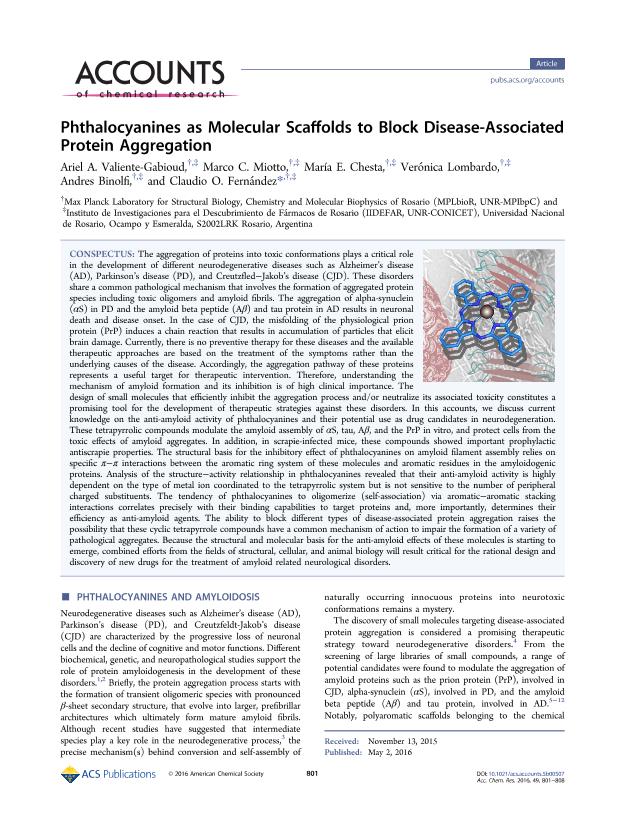Artículo
Phthalocyanines as Molecular Scaffolds to Block Disease-Associated Protein Aggregation
Valiente Gabioud, Ariel Alejandro ; Miotto, Marco César
; Miotto, Marco César ; Chesta, María Eugenia
; Chesta, María Eugenia ; Lombardo, Veronica Andrea
; Lombardo, Veronica Andrea ; Binolfi, Andrés
; Binolfi, Andrés ; Fernandez, Claudio Oscar
; Fernandez, Claudio Oscar
 ; Miotto, Marco César
; Miotto, Marco César ; Chesta, María Eugenia
; Chesta, María Eugenia ; Lombardo, Veronica Andrea
; Lombardo, Veronica Andrea ; Binolfi, Andrés
; Binolfi, Andrés ; Fernandez, Claudio Oscar
; Fernandez, Claudio Oscar
Fecha de publicación:
05/2016
Editorial:
American Chemical Society
Revista:
Accounts of Chemical Research
ISSN:
0001-4842
Idioma:
Inglés
Tipo de recurso:
Artículo publicado
Clasificación temática:
Resumen
ConspectusThe aggregation of proteins into toxic conformations plays a critical role in the development of different neurodegenerative diseases such as Alzheimer's disease (AD), Parkinson's disease (PD), and Creutzfled-Jakob's disease (CJD). These disorders share a common pathological mechanism that involves the formation of aggregated protein species including toxic oligomers and amyloid fibrils. The aggregation of alpha-synuclein (αS) in PD and the amyloid beta peptide (Aβ) and tau protein in AD results in neuronal death and disease onset. In the case of CJD, the misfolding of the physiological prion protein (PrP) induces a chain reaction that results in accumulation of particles that elicit brain damage. Currently, there is no preventive therapy for these diseases and the available therapeutic approaches are based on the treatment of the symptoms rather than the underlying causes of the disease. Accordingly, the aggregation pathway of these proteins represents a useful target for therapeutic intervention. Therefore, understanding the mechanism of amyloid formation and its inhibition is of high clinical importance. The design of small molecules that efficiently inhibit the aggregation process and/or neutralize its associated toxicity constitutes a promising tool for the development of therapeutic strategies against these disorders. In this accounts, we discuss current knowledge on the anti-amyloid activity of phthalocyanines and their potential use as drug candidates in neurodegeneration. These tetrapyrrolic compounds modulate the amyloid assembly of αS, tau, Aβ, and the PrP in vitro, and protect cells from the toxic effects of amyloid aggregates. In addition, in scrapie-infected mice, these compounds showed important prophylactic antiscrapie properties. The structural basis for the inhibitory effect of phthalocyanines on amyloid filament assembly relies on specific π-π interactions between the aromatic ring system of these molecules and aromatic residues in the amyloidogenic proteins. Analysis of the structure-activity relationship in phthalocyanines revealed that their anti-amyloid activity is highly dependent on the type of metal ion coordinated to the tetrapyrrolic system but is not sensitive to the number of peripheral charged substituents. The tendency of phthalocyanines to oligomerize (self-association) via aromatic-aromatic stacking interactions correlates precisely with their binding capabilities to target proteins and, more importantly, determines their efficiency as anti-amyloid agents. The ability to block different types of disease-associated protein aggregation raises the possibility that these cyclic tetrapyrrole compounds have a common mechanism of action to impair the formation of a variety of pathological aggregates. Because the structural and molecular basis for the anti-amyloid effects of these molecules is starting to emerge, combined efforts from the fields of structural, cellular, and animal biology will result critical for the rational design and discovery of new drugs for the treatment of amyloid related neurological disorders.
Palabras clave:
Phthalocyanines
,
Neurodegenerative
,
Aggregation
,
Parkinson
Archivos asociados
Licencia
Identificadores
Colecciones
Articulos(CCT - ROSARIO)
Articulos de CTRO.CIENTIFICO TECNOL.CONICET - ROSARIO
Articulos de CTRO.CIENTIFICO TECNOL.CONICET - ROSARIO
Citación
Valiente Gabioud, Ariel Alejandro; Miotto, Marco César; Chesta, María Eugenia; Lombardo, Veronica Andrea; Binolfi, Andrés; et al.; Phthalocyanines as Molecular Scaffolds to Block Disease-Associated Protein Aggregation; American Chemical Society; Accounts of Chemical Research; 49; 5; 5-2016; 801-808
Compartir
Altmétricas



